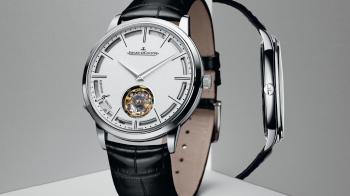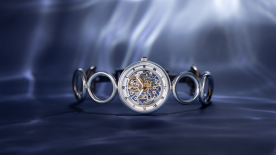Jaeger-LeCoultre celebrated its 180th anniversary in 2013. For this momentous occasion, they released a fleet of exceptional timepieces, including the Master Grande Tradition Gyrotourbillon 3 Jubilee, the world’s first (and only) spherical flying tourbillon. The following year, all eyes were turned elsewhere, assuming that Jaeger-LeCoultre would take a break from blockbuster watchmaking and rest on their well-deserved laurels.
In a stunning turn of events, they instead launched the 11th watch in their collection of extraordinary timepieces known as Hybris Mechanica. As far as I’m concerned, this watch, the Master Ultra Thin Minute Repeater Flying Tourbillon is among the top three modern watches made by Jaeger-LeCoultre, from a technical perspective. While it’s not as complicated as the Duomètre à Grande Sonnerie (2009), or as eye-catching as the multi-dial Reverso cal. 185 Quadriptyque (2021) with its rare astronomical indications, it is the watch that best represents the two greatest strengths of Jaeger-LeCoultre. One of those strengths is traditional watchmaking expertise, in areas as varied as ultra-thin watches, rotating escapements and chiming watches. The other is envelope-pushing innovation. The latter strength isn’t as widely acknowledged as the former, partly because the maison largely stays within the classic design milieu, which allows its technical audacity to fly under the radar. Also, the truly impressive innovations of Jaeger-LeCoultre are not easy to discuss or comprehend, not even for the seasoned watch enthusiast. The Master Ultra Thin Minute Repeater Flying Tourbillon is rightly celebrated for its record-setting ultra-thin construction, its high-performance peripheral rotor, and its improvements in chiming technology, but its most outstanding accomplishment lies at the heart of its tourbillon.
Casual observers will see the rotating escapement at the 6 o’clock position and note the presence of a tourbillon – a flying tourbillon, as indicated by the name of the watch. What they might not notice is that this is no ordinary flying tourbillon. The uppermost component of a conventional flying tourbillon is its cage, with no bridge to hold it in place. Not only is there no bridge to speak of in the Master Ultra Thin Minute Repeater Flying Tourbillon, there is no cage either. There is only the balance, unbridged and uncaged.
Now, this poses a huge problem. In any other movement, there has to be something above the balance, immobile relative to the oscillation of the balance, to which the hairspring stud can be fixed. In non-tourbillon movements, this is usually the balance cock and index. In a tourbillon movement, you pin the hairspring stud to the cage. Without this fixed element, the hairspring cannot function as an oscillator.
Jaeger-LeCoultre removed the tourbillon cage from their tourbillon, but they also did a lot of other stuff. This allowed the tourbillon not only to keep working, but with greater hairspring concentricity and less height. In other words, they broke the fundamental principles of tourbillon construction and still ended up with a superior mechanism. How exactly did they do it?
Firstly, they reversed the pinning points of the hairspring. The outer coil, which is usually pinned to a stud and then fixed to the tourbillon cage (or balance cock), is instead pinned to an arm of the balance wheel. The inner coil of the hairspring, usually pinned to the balance staff, is instead pinned to the tourbillon carriage arbour. Tourbillon scholars will know what this means. Not only did Jaeger-LeCoultre eliminate the need for a tourbillon cage, they also eliminated the need for a balance staff.
With the inner terminal of its hairspring pinned closer than ever to the hairspring’s centre of gravity and oscillation, the Master Ultra Thin Minute Repeater Flying Tourbillon is aligned – more than any other tourbillon – with the chronometrically ideal construction of a regulating organ. Without the tourbillon cage, the overall height is decreased and the stability of what is essentially a high-speed cantilevered oscillating component is improved. Jaeger-LeCoultre were able to incorporate a larger balance, freed from the spatial constraints of a cage, reducing the vulnerability of the regulating organ to shocks and other external perturbations.
One of the most persistent misconceptions about tourbillons is that they are magical horological accessories that automatically improve the chronometric performance of a watch. In fact, they are tools whose ability to help or hinder depends very much on how they are used. The in-house knowledge and mastery of Jaeger-LeCoultre are such that their tourbillons rank among the very best in the entire history of mechanical watchmaking. And considering how quickly records are set and subsequently broken in the realm of ultra-thin watchmaking, it is a testament to Jaeger-LeCoultre’s expertise that the Master Ultra Thin Minute Repeater Flying Tourbillon remains the world’s thinnest automatic tourbillon minute repeater to this day.
*This year GMT Magazine and WorldTempus have embarked on the ambitious project of summarising the last 20 years of the Tourbillon in The Millennium Watch Book - Tourbillons, a big, beautifully laid out coffee table book. This article is an extract. The Millennium Watch Book - Tourbillons is available on www.the-watch-book.com, in French and English.





